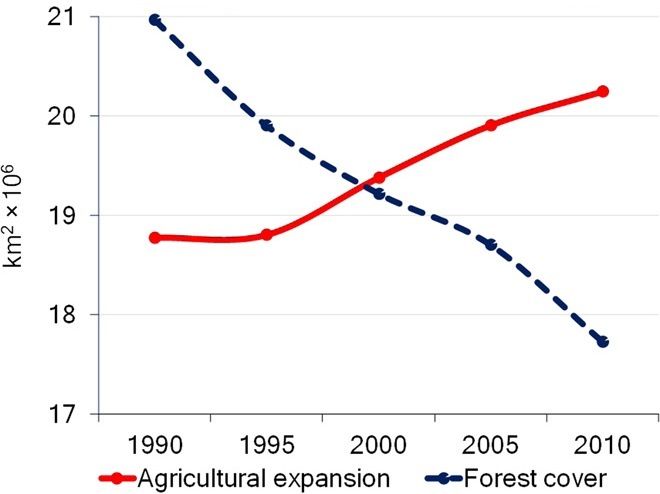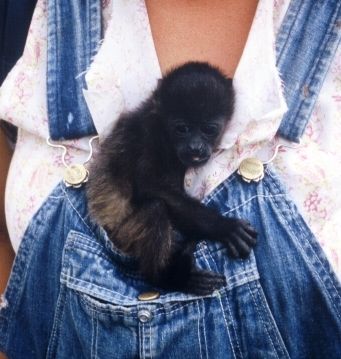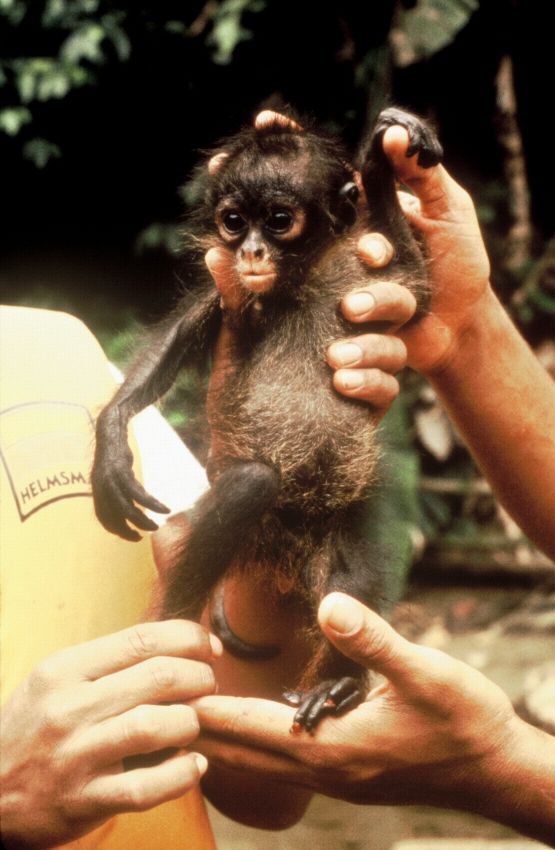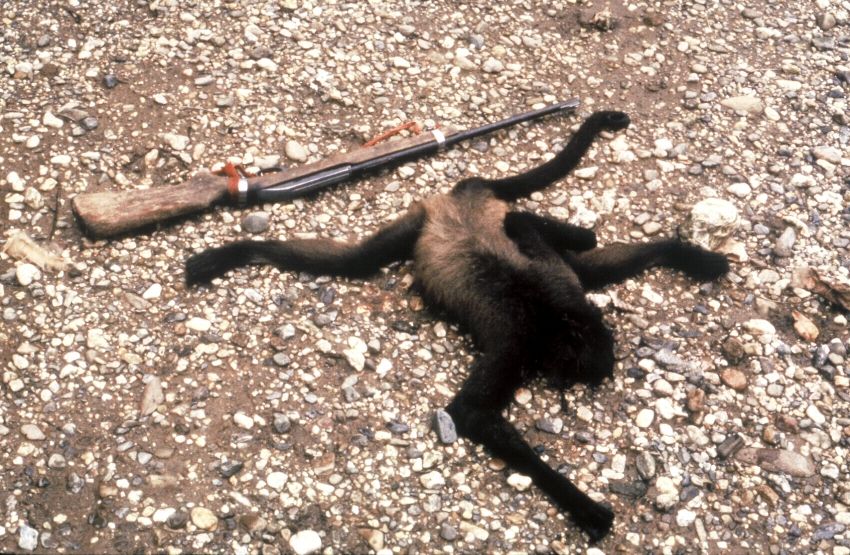One Primate’s Population Soars, Causing Hundreds of Others to Sink
Published on January 23rd, 2017
On Planet Earth as a whole, the population of exactly one species of primate is surging, at the expense of hundreds of other primate species.
 |
|
Primates, our nearest animal relatives on Earth, are
in dire straits: a young chimpanzee enjoying life.
|
The one species that is surging would be our own of course, Homo sapiens. We humans are now 7.5 billion strong – counting and mounting – piling on 90 million more of us every year, at an average rate of about 245,000 per day, equal to the population of another Los Angeles every two weeks. It is simply staggering: the population bomb didn’t fizzle, it’s still in mid-explosion.
The pressures and stresses exerted by this extraordinary human population eruption are causing the populations of hundreds of nonhuman primate species that share Planet Earth with us to crash. A large number are crashing all the way to the brink of extinction.
Those are the ominous findings of a comprehensive new study, “Impending extinction crisis of the world’s primates: Why primates matter,” in the journal Science Advances, published by the American Association for the Advancement of Science (AAAS).

Primates are our closest relatives in the Animal Kingdom and our nearest kin in the cosmos. We share a lengthy evolutionary history with nonhuman primates – tens of millions of years in the making – and with it many common morphological, physiological and behavioral traits, including prehensile (capable of grasping) hands and feet, flexible shoulders and hip joints, relatively large brains, communication and social behavior.
More than 500 species of the primate taxonomic order exist on Earth; there are more species of primates than any other order of mammal, except for bats and rodents. The estimated 504 species occur in 79 genera and are distributed across the neotropics (tropical terrestrial ecoregions of the Americas and all of the South American temperate zone), mainland Africa, Madagascar and Asia.
Disturbingly, about 75 percent of primate species are now facing population declines, and 55 percent are actually threatened with extinction. On the island of Madagascar (Fig. 1), a well-known “hot spot” of primate biodiversity, 100 percent of primates are experiencing declining populations, and 87 percent are facing extinction. Our nearest relatives are in deep trouble.
The Science Advances report identifies the main threats to primates as:
-
Loss of habitat due to agriculture (76% of species) (Fig. 2)
-
Loss of habitat due to logging and wood harvesting (60%)
-
Direct loss due to hunting and trapping (60%)
-
Loss of habitat due to livestock farming and ranching (31%)
-
Loss of habitat due to road and rail construction, oil and gas drilling, and mining (2-13% of species).
 |
|
Figure 2. Expanding agriculture and declining forest cover in
the American neotropics,Africa and Southeast Asia.
|
Emerging threats to primates include pollution and climate change.
Of course, virtually all of the above threats to primates are linked to the size and rapid growth of human populations in and around their habitats. Humans obliterate primate habitats – their forest homes – to make way for ever more food and fiber production to feed and shelter more and more people. Humans also kill primates en masse to eat them directly and for their body parts. They also murder the parents of monkeys to take their infants for the pet trade.
 |
|
|
An orphaned howler monkey in Honduras, “rescued” by a Peace Corps Volunteer who unwittingly contributed
to the illicit pet trade.
|
When I was a Peace Corps Volunteer promoting conservation in rapidly growing Honduras in Central America (i.e., the neotropics), I witnessed firsthand both habitat destruction and direct killing. One Peace Corps friend of mine unwittingly contributed to the illegal pet trade when she purchased a baby monkey – because she felt sorry for the hapless, homeless little critter – being peddled by roaming street vendors in the village in which she resided. She only learned later that it was an endangered howler monkey.
I observed a mother of another species – spider monkey – killed and eaten by Miskito Indians with whom I was traveling in the jungle; the cute baby clinging to its breast in the treetops was snatched as a pet.
Unlike so much commentary and hand-wringing by contemporary, overpopulation-denying environmentalists, who nowadays deliberately downplay and obfuscate the potent role of human population growth in driving the global assault on biodiversity – the Science Advances report is explicit in fingering population as one of the key factors underlying the threats primates face.
 |
| An orphaned spider monkey whose mother I’d just seen shot dead in the Honduran rainforest. |
 |
| Female spider monkey shot and killed moments before by a man wielding the ancient .22 rifle shown; this monkey was mother to the baby shown in the above photo. |
The Science Advances authors write:
“Solutions to the challenge of primate conservation must include reducing human birth rates and population growth, improving health, reducing poverty and gender biases in education, developing sustainable land-use initiatives, and preserving traditional livelihoods. Locally, people and governments need to become stakeholders in this effort and perceive that they can benefit from protecting primate populations and their forests while at the same time satisfying their basic needs [emphasis added].”
Achieving all of these prescriptions is a tall order indeed. But if we fail, the future for nonhuman primates – our nearest kin on the planet, in the solar system, the galaxy and the universe – is bleak. Many of them will have no future at all; we will see the permanent oblivion of extinction. That would be tragic, and one would hope this fate could be avoided if enough individuals of the primate with the largest brain of all could also demonstrate that they have hearts to match.
Postscript to the monkey-killing incident I witnessed in the rainforest Mosquitia region of Honduras
After complaining bitterly to my Miskito Indian hosts several days earlier about the wanton, unnecessary killing of a mother spider monkey with suckling infant, I wrote the following passage in chapter nine, “Farewell to the Mosquitia,” of my book Bright River, Dark Dreams: Tragedy on the Río Plátano:
“We ate, broke camp, and loaded up the pipantes [dugout canoes carved out of mahogany logs] to begin our downstream ride back to Las Marias. I had just taken my place, and Cástulo was about to push us off the bank, when I heard a sound that made me cringe: a troop of monkeys was approaching to investigate us. Cástulo looked up and hesitated, as did all of the Miskitos….
“Then I saw them up there in the leafy canopy of the forest which sloped down the canyon side: the bobbing little heads, the swinging arms and the groping tails of seven or eight monkeys approaching us. Would their curiosity get them killed? It all depended on the Miskitos. I held my breath.
“Cástulo turned around and examined me solemnly for a moment. Then he announced for all to hear: ‘These we will not hunt. We have to take care for how many animals we kill. If we kill too many today, there won't be any for tomorrow.’ I sighed internally with relief, and nodded externally to show that I sanctioned his decision. Maybe they would become conservationists after all.
“Yet I couldn't help but wonder if this restraint wasn't being exercised merely in polite deference to my tender sensibilities. Would Cástulo and the others have muzzled their weapons if I hadn't been there? If we didn't already have a more than ample food supply? I don't know, but at least now I was spared having to view another bloody, heartrending scene.”

Conservation status / photo credit
A) Golden snub-nosed monkey (Rhinopithecus roxellana), Endangered / P. A. Garber
B) Ring-tailed lemur (Lemur catta), Endangered / R. A. Mittermeier
C) Udzungwa red colobus (P. gordonorum), Endangered / Thomas Struhsaker, Duke University
D) Javan slow loris (Nycticebus javanicus), Critically Endangered / Andrew Walmsley Photography
E) Sumatran orangutan (P. abelii), Critically Endangered / Perry van Duijnhoven
F) Azara’s night monkey (Aotus azarae), Least Concern / Claudia Valeggia, Yale University, Owl Monkey Project, Formosa-Argentina.




